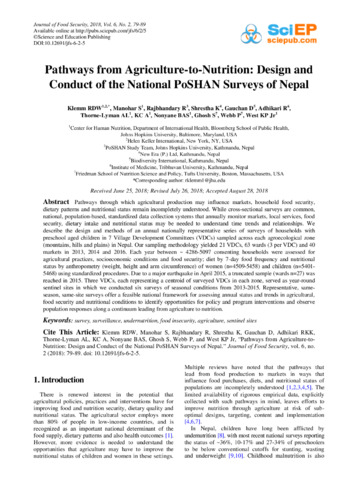Pathways from agriculture-to-nutrition: Design and conduct of the National PoSHAN surveys of Nepal
Pathways through which agricultural production may influence markets, household food security, dietary patterns and nutritional status remain incompletely understood. While cross-sectional surveys are common,
national, population-based, standardized data collection systems that annually monitor markets, local services, food security, dietary intake and nutritional status may be needed to understand time trends and relationships. We
describe the design and methods of an annual nationally representative series of surveys of households with preschool aged children in 7 Village Development Committees (VDCs) sampled across each agroecological zone (mountains, hills and plains) in Nepal. Our sampling methodology yielded 21 VDCs, 63 wards (3 per VDC) and 40
markets in 2013, 2014 and 2016. Each year between ~ 4286-5097 consenting households were assessed for agricultural practices, socioeconomic conditions and food security; diet by 7-day food frequency and nutritional status by anthropometry (weight, height and arm circumference) of women (n=4509-5458) and children (n=5401-
5468) using standardized procedures. Due to a major earthquake in April 2015, a truncated sample (wards n=27) was reached in 2015. Three VDCs, each representing a centroid of surveyed VDCs in each zone, served as year-round sentinel sites in which we conducted six surveys of seasonal conditions from 2013-2015. Representative, sameseason, same-site surveys offer a feasible national framework for assessing annual status and trends in agricultural, food security and nutritional conditions to identify opportunities for policy and program interventions and observe
population responses along a continuum leading from agriculture to nutrition.

